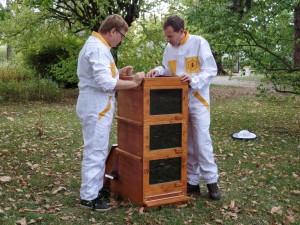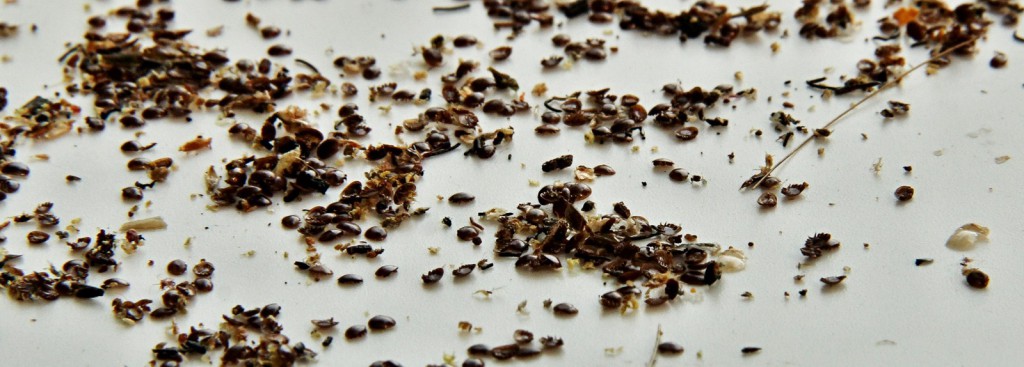Hive Uses Sun to Destroy Parasite
By Dr. Roman Linhart, Heřmanův Městec, Czech Republic
It has been known for several decades that the parasitic mite Varroa destructor is very sensitive to increased temperatures. At temperatures just a few degrees higher than the optimum, the mite is no longer able to reproduce. Long-term exposure to temperatures above 38°C cause irreversible damage, and temperatures above 40°C destroy the mite completely.
Properly performed thermotherapy is much friendlier to the bees than the use of any chemical drugs. In terms of efficiency, it can be a complete substitute to chemical drugs and its potential is considerable even on ecological farms. However, hitherto existing devices used to kill mites by thermotherapy were very expensive, user-intensive and dependent on electricity. Although the first devices appeared in the 80s, due to the above mentioned shortcomings it has never been used extensively in beekeeping practice and remained a rather marginal method used mainly by researchers. Nonetheless, thermotherapy possesses enormous potential, which we managed to exploit.

Based on 12 years of testing and beekeeping research carried out in Central Europe in cooperation with Palacky University Olomouc (Czech Republic, EU), the Thermosolar Hive™ was developed. It is a full-fledged beehive consisting of boxes which can simultaneously and with great efficiency exterminate Varroa mites in the capped brood by thermotherapy.
Thermosolar Hive is suitable for beekeepers in all climate zones and in all frame sizes, but it needs sunshine to be effective. Therefore it is unsuitable for placing in shaded habitats or indoor apiaries.
The hive contains two heating systems which complement each other. The whole structure of the hive has been designed to effectively increase and maintain high temperature in the brood nest. Under the roof of the hive there is a thermosolar ceiling. It is used only for a short intense heat treatment; otherwise, it is covered with a roof.
After sufficient solar irradiation, the roof is removed to increase the temperature in the brood nest to 40-47°C. Thanks to special insulation of the whole hive this temperature is maintained in the brood nest for the required period of more than 2 hours. Mortality of mites in capped brood is 100%.
The thermosolar ceiling contains two thermometers with sensors that are inserted into the wax of the brood frame. Therefore, throughout the thermotherapy, the beekeeper has full control of temperatures; if there is a risk of overheating, he/she can intervene by placing the roof back and thus end the heating process.
Short, intense thermal treatment is applied usually two times per year. Given that thermotherapy is carried out with open entrance, the heating should be repeated after 7-14 days, as after that period those mites that were stuck on adult bees and so escaped the first heating get capped in the brood. This two-stage treatment therefore ensures that the colony is completely rid of the mite.

Unlike house bees and brood, adult bees can tolerate a higher temperature for a limited time. Increased temperature, however, does not harm them, because they can draw off to the bottom box of the treated beehive, possibly hang on the mezzanine floor, or leave the hive completely. Many tests over the years have proved that the larvae endure heating too. In correctly performed thermotherapy the brood cannot be killed or damaged.
On sunny days the hive raises the temperature of the brood chamber slightly above 35.5°C, thus effectively preventing the reproduction of Varroa mites. In fact, when the temperature exceeds 38°C, female mites are damaged and become infertile. It is a known fact that by heating the worker brood over that limit, Apis cerana prevents mites. On that bee, Varroa mites reproduce only on drone brood. Thermosolar Hive can, without any harm to the brood, achieve the same effect on honeybees; long-term heating minimizes the reproductive ability of mites.
Due to the constant slow heating of the hive space using thermosolar windows in individual boxes and its special construction, the Thermosolar Hive is also able to provide long-term thermal comfort of the colony.
Moderate long-term warming has been proved to significantly reduce the consumption of reserves during wintering, it accelerates spring development by an average of 14 days, and it prevents the onset of nosema. At the same time windows in individual boxes act as supportive heating during the thermotherapy.
A considerable advantage of mild long-term heating is a significant increase in honey yield, as on sunny days all the bees can engage in flow; they need not spend time heating the brood. These benefits are reported not only from our own testing, but by almost a hundred beekeepers who tested the Thermosolar Hive in 2015. More information can be found on www.thermosolarhive.com.

[infobox title=’Dr. Roman Linhart’] Dr. Roman Linhart of Heřmanův Městec, Czech Republic first trained as a fruiterer and beekeeper apprentice in Nasavrky. Then he worked as a professional beekeeper in the field of pollination of Brassicaceae and ornamental bulbous plants. After gaining his Master’s degree he worked as zoologist – entomologist for the Nature Conservation Agency of the Czech Republic. Professionally Dr. Linhart focuses on evolutionary biology of honeybees, sociobiology, eto-ecology, and epizootology of bee and bee brood diseases.[/infobox]
Dr. Roman Linhart of Heřmanův Městec, Czech Republic first trained as a fruiterer and beekeeper apprentice in Nasavrky. Then he worked as a professional beekeeper in the field of pollination of Brassicaceae and ornamental bulbous plants. After gaining his Master’s degree he worked as zoologist – entomologist for the Nature Conservation Agency of the Czech Republic. Professionally Dr. Linhart focuses on evolutionary biology of honeybees, sociobiology, eto-ecology, and epizootology of bee and bee brood diseases.[/infobox]












